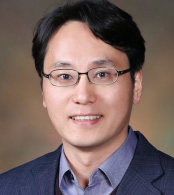SEMINAR 2023
Quantum Transport from a Multi-Space Excitation Viewpoint
| Speaker | Yong-Hoon Kirn, Korea Advanced Institute of Science and Technology (KAIST) |
| Date/Time | Thursday, 16 November, 10am |
| Location | Conference room: S11-02-07 |
Abstract
In the effort to develop novel functional materials and advanced devices based on them, first-principles or ab initio simulations are playing an increasingly important role by providing atomistic information that are not easily accessible in experiments. In this respect, a key ingredient that is still immature and should be further developed is the capability to treat non-equilibrium open junction systems under finite bias in a first-principles manner. For example, for graphene electrode-based van der Waals 2D tunneling transistors, ab initio simulations are currently not possible due to the inherent limitations of the standard approach combining density functional theory (DFT) and non-equilibrium Green’s function (NEGF) formalisms [1,2]. In this talk, I will discuss the formulation and applications of the multi-space constrained-search DFT (MS-DFT) formalism we have been developing at KAIST for the past decade plus [1-4]. Seeking an alternative to the standard Landauer picture for quantum transport, we first propose a viewpoint that maps quantum transport processes to drain-to-source (real-space) optical (energy-space) excitation counterparts. The multi-space excitation picture for quantum transport then allows the formulation of microcanonical approaches for quantum transport, and the resulting MS-DFT provides unique opportunities in understanding and designing nanoscale devices in operando conditions. Specifically, the non-equilibrium total energy as well as quasi-Fermi level or voltage drop profile information can be obtained [3,4], graphene electrode-based 2D devices can be faithfully modeled [I,2], and the electric enthalpy or the non-equilibrium molecular adsorption energy can be defined for electrified interfaces [5].
[1] H. S. Kim & Kim, Y.-H. “Constrained-search density functional study of quantum transport in two-dimensional vertical heterostructures”, arXiv:1808.03608 [cond-mat.mes-hall] (2018).
[2] T. H. Kim, J. Lee, R. Lee, & Y.-H. Kim, “Gate-versus defect-induced voltage drop and negative differential resistance in vertical graphene heterostructures”, npj Comput. Mater. 8, 50 (2022).
[3] J. Lee, H. S. Kim, and Y.-H. Kim, “Multi-space excitation as an alternative to the Landauer picture for non-equilibrium quantum transport”, Adv. Sci. 7, 2001038 (2020).
[4] J. Lee, H. Yeo, and Y.-H. Kim, “Quasi-Fermi level splitting in nanoscale junctions from ab initio”, Proc. Natl. Acad. Sci. U.S.A. 117, 10142 (2020).
[5] J. Lee, H. Yeo, R. Lee, and Y.-H. Kim, “Theory of electric enthalpy in electrified interfaces”, (submitted).

Group homepage: http://nanocore.kaist.ac.kr
